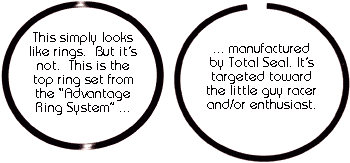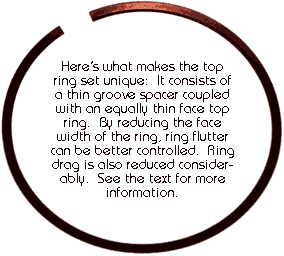| 
So what’s the answer? One way to resolve this issue is to use a skinny top ring. Of course, if the piston ring groove size is predetermined (as in rules for Stock Eliminator, or simply by the grooves you have in your pistons), then you have to look at other options. One that we know of is available from Total Seal. They have a new ring package that simply begs racers and hot rodders to look at it. In essence, this top ring package, called the “Advantage Ring System” is based around a ring groove spacer (positioned on the top side of the ring groove), coupled with a skinny 0.0469-inch top ring.
 The actual top ring is a more or less conventional “torsional” ring with a moly face. But the big difference is the width. The ring measures 0.0469-inches (approximately 3/64-inch, or in today’s industry parlance, 1.2 millimeters). Now, a conventional 5/64-inch ring measures approximately 0.0780-inches in width while a conventional 1/16-inch ring measures approximately 0.0625-inches in width. With the Total Seal package, the balance is filled with a spacer, which has a width of 0.031-inch each (0.031” + 0.0469” = 0.078” or 5/64-inch). These are pretty close dimensions. The actual top ring is a more or less conventional “torsional” ring with a moly face. But the big difference is the width. The ring measures 0.0469-inches (approximately 3/64-inch, or in today’s industry parlance, 1.2 millimeters). Now, a conventional 5/64-inch ring measures approximately 0.0780-inches in width while a conventional 1/16-inch ring measures approximately 0.0625-inches in width. With the Total Seal package, the balance is filled with a spacer, which has a width of 0.031-inch each (0.031” + 0.0469” = 0.078” or 5/64-inch). These are pretty close dimensions.
Total Seal has spent considerable resources working on ways to improve upon piston ring tolerances. You see, the capability to maintain near-perfect groove tolerances in pistons
ADVERTISEMENT
 |
has advanced in recent years (many of today’s incredibly accurate, CNC-machined pistons are evidence of this). But for the most part, ring dimensional tolerance hasn’t kept pace. It makes sense (at least to us) that if the ring groove is near perfect, but the actual ring is out-of-whack, then you have a problem.
To this end, Total Seal has invested in equipment and tooling which allows them to manufacture rings to meet exceedingly close dimensional tolerances. How tight can they control tolerances? Try 50-millionths of an inch for ring flatness! Typically, Total Seal can maintain a R/A of 8 to 11 microns/inch. In comparison, more conventional rings usually have a R/A of between 20 and 30 microns/inch. And that’s how the “Advantage Ring System” came about (it’s also why a number of professional racers are switching to Total Seal Rings).
 Getting back to the rings: Even though the ring and double spacer combination is unique, Total Seal still recommends that the ring-to-piston groove back clearance be maintained at a minimum of 0.005-inch deeper than the radial wall dimension of the piston ring. The bottom line here is, if the ring sticks out of the groove by any amount, you either have the wrong piston ring or the piston ring groove isn’t correct. With the spacers installed, the ring groove side clearance (see illustration #1) should still be a minimum of 0.0015-inch to a maximum o 0.003-inch. Getting back to the rings: Even though the ring and double spacer combination is unique, Total Seal still recommends that the ring-to-piston groove back clearance be maintained at a minimum of 0.005-inch deeper than the radial wall dimension of the piston ring. The bottom line here is, if the ring sticks out of the groove by any amount, you either have the wrong piston ring or the piston ring groove isn’t correct. With the spacers installed, the ring groove side clearance (see illustration #1) should still be a minimum of 0.0015-inch to a maximum o 0.003-inch.
The second ring in this set is a gapless ring (the configuration that basically put Total Seal in business). Over the years, the gapless ring technology has improved. There are a couple of different gapless rings configurations available from different manufacturers, but Total Seal was the originator. Before we look at the Gapless ring, let’s review what the second ring really does:
The second ring is probably the most misunderstood ring application of all the rings used on a piston. With a conventional piston ring the ring design is similar to the top ring. It also has a ring gap that allows hot gases to further penetrate down the cylinder wall into the crankcase oil (blow-by). The second ring also serves as an oil scraper ring to help minimize the oil above the second ring and as such compliments both the compression ring and the oil ring.

|
